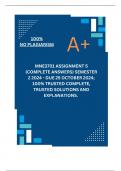, Having acquired sufficient knowledge and skills on entrepreneurship and
small business management, you must demonstrate practical competencies in
managing business’s assets and risks. Think of any business you would like
to start and answer the following questions:
QUESTION 1 By using practical examples, critically discuss how you would
manage the assets of your business. (10)
Managing Business Assets: A Practical Approach
1. Understanding Business Assets
To effectively manage the assets of a business, it is crucial to first understand what
constitutes business assets. Assets can be classified into several categories: current
assets (cash, inventory, accounts receivable), fixed assets (property, plant, equipment),
and intangible assets (patents, trademarks). For this discussion, I will consider starting a
small café as an example of a business.
2. Inventory Management
One of the most significant assets for a café is its inventory, which includes food and
beverage supplies. To manage this asset effectively:
Implement Inventory Control Systems: Utilizing software like Square or Toast can
help track inventory levels in real-time. This allows for timely reordering and minimizes
waste due to spoilage.
Regular Audits: Conducting weekly inventory audits ensures that stock levels are
accurate and helps identify any discrepancies or theft.
Supplier Relationships: Building strong relationships with suppliers can lead to better
pricing and terms, ensuring that the café maintains quality while managing costs.





